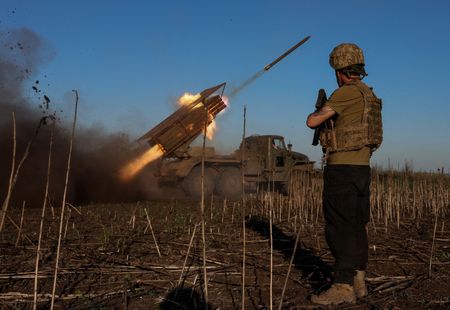By Andrius Sytas
VILNIUS (Reuters) -Smuggling balloons floating over the border from Belarus have shut down the airport in Lithuania’s capital Vilnius for four evenings over the past week, with authorities branding it a “hybrid attack” by the Kremlin ally.
Dozens of flights have been redirected or cancelled at the airport, which is 30 kilometres (19 miles) from Belarus, with thousands of passengers affected.
Lithuania, a NATO and European Union member state, has shut its land border with Belarus until the end of November in response, and threatened to call for NATO Article 4 consultations if these incidents continue.
Here is what is known about these balloons:
WHAT ARE THEY?
The high-altitude balloons, filled with helium or hydrogen, fly where the wind takes them but their altitude can be controlled remotely from the ground.
They are typically used by meteorologists to sound out weather conditions in the stratosphere, which starts 15 kilometres (9.3 miles) above ground.
However, they have been repurposed by smugglers to carry cheaper cigarettes from Belarus into Lithuania, the Vilnius government says, since a crisis over a wave of migrant crossings in 2021 led to tighter curbs on movement over the land border.
First spotted in 2023, the smuggling balloons became ubiquitous in 2024 when several hundred were recorded.
They pass over the border at an altitude of about 3-4 kilometres. The smugglers in Lithuania can then communicate with the balloon to track its location, and direct it to land.
A balloon typically carries 500 to 1,500 packs of Belarus-produced cigarettes, with a pack costing less than a euro, versus 4.5 euros per similar brand in Lithuania.
WHY ARE THE BALLOONS A PROBLEM?
Air navigation authorities say the balloons fly at a similar height to airliners approaching an airport, raising the risk of collisions.
Local rules for what constitutes a mid-air risk have recently been upgraded, and the balloons now frequently qualify.
In recent days, Lithuanian authorities have fine-tuned their detection systems and have been able to better identify whether the flight paths of any identified balloons pose a threat to civil aviation.
WHAT HAPPENS WITH THE CIGARETTES?
Lithuania says smuggled cigarettes are typically manufactured in Belarus and many are consumed in Lithuania.
The Lithuanian Border Guard confiscated 1.4 million packs of illicit cigarettes in 2024, of which 1.2 million packs were marked for sale in Belarus.
WHY DID LITHUANIA CLOSE ITS BORDER WITH BELARUS?
The Lithuanian government says Belarus authorities are contributing to the problem by not cracking down on smugglers on their soil, and has deemed the situation a “hybrid attack”.
WHAT IS BELARUS’ POSITION?
“If some air balloons with cigarettes or something else are flying there (Lithuania), they need to solve that question there. They are not flying into nothing, someone is receiving them there,” President Alexander Lukashenko said.
He said Lithuania’s closure of the border was a “crazy scam” and, in turn, accused the West of waging a hybrid war against Belarus and Russia that was ushering in a new era of barbed-wire division.
Foreign Minister Maxim Ryzhenkov called Lithuania’s move “a provocation” that he said aimed to justify anti-Belarus sanctions.
WHY AREN’T THE BALLOONS SHOT DOWN?
The Lithuanian government initially said they were not being shot down because of the danger to lives or property posed by their payloads, which can be as heavy as 50 kilograms (110 pounds), if they fell uncontrollably.
On Monday, however, Prime Minister Inga Ruginiene told the army to use “kinetic measures” to destroy the balloons. She did not elaborate on the measures, citing security sensitivities.
(Reporting by Andrius Sytas in Vilnius; editing by Mark Heinrich)










